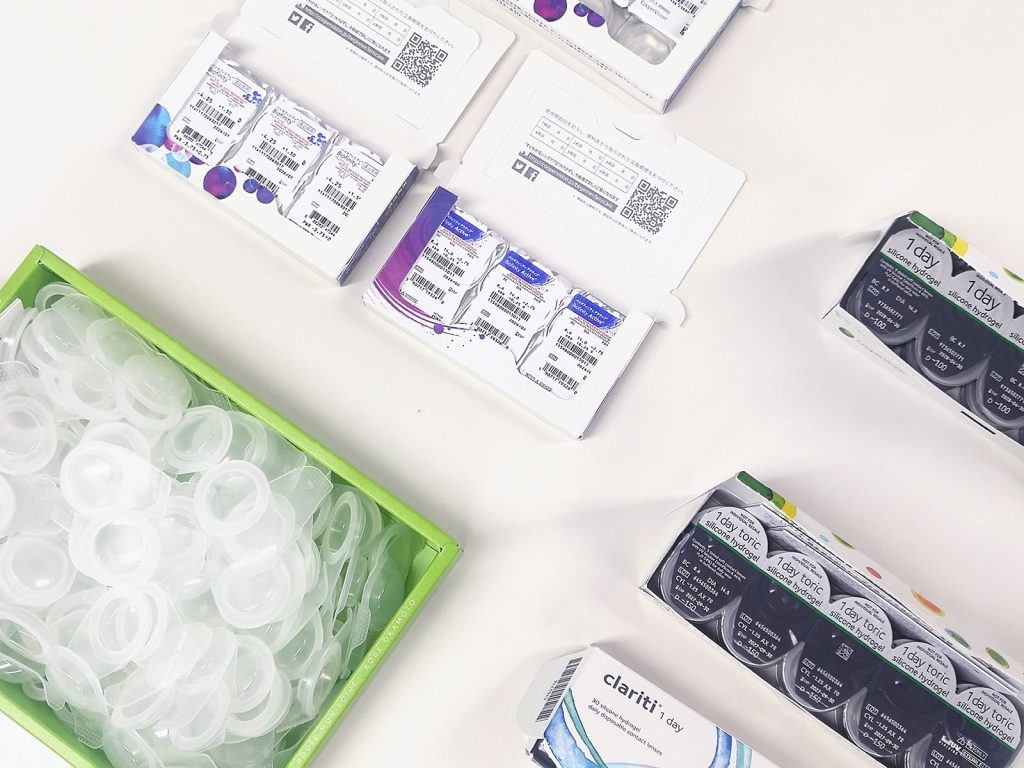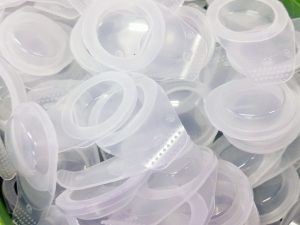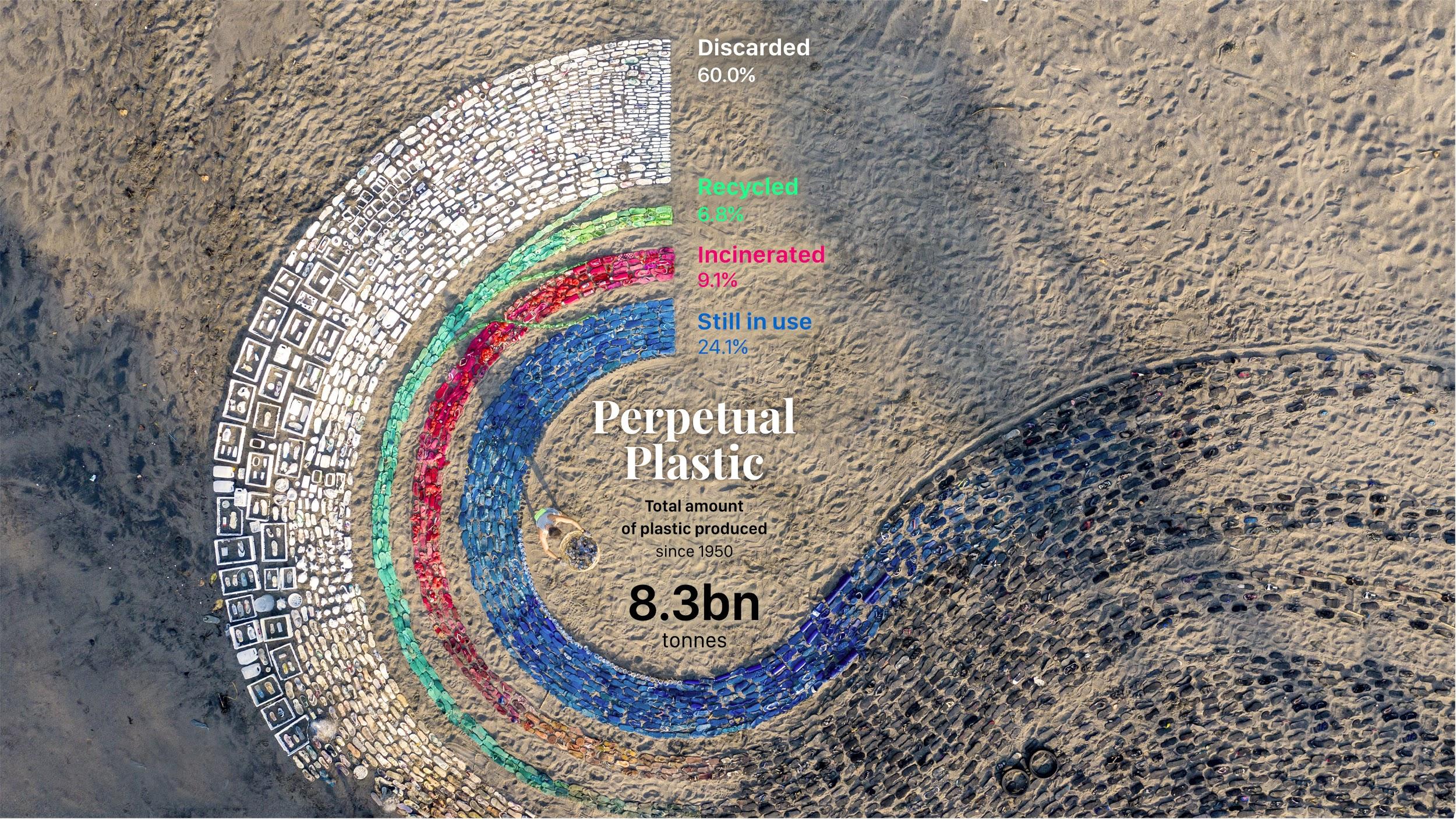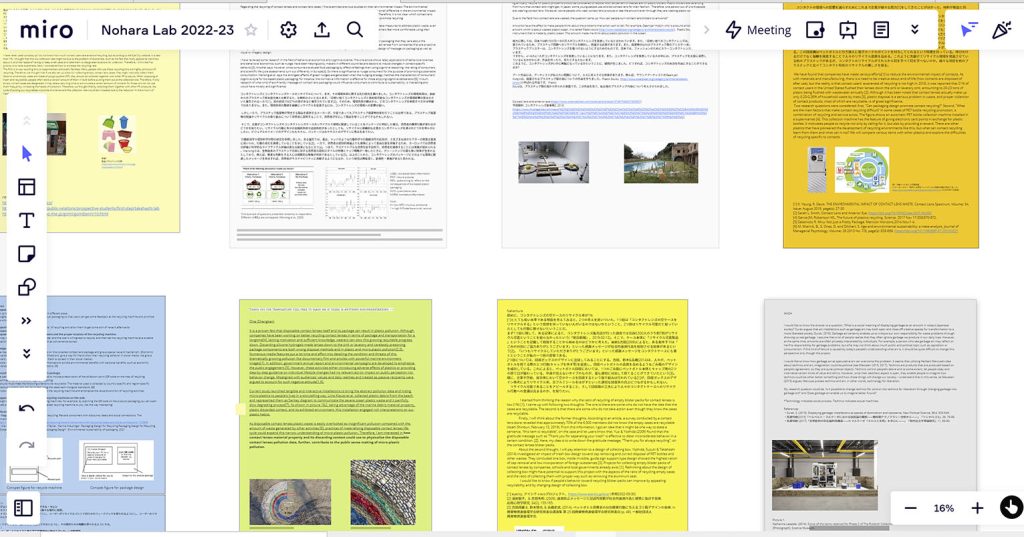東工大野原研究室では、コンタクトレンズの大手メーカー、クーパービジョン・ジャパンとの新コラボレーションを開始しました。コンタクトレンズ製品の、製造工程が環境に与える影響は少なくありません。使い捨てプラスチックへの依存を減らそうと、世界規模の模索が始まっています。プラスチックは化学的・物理的に弾力性を持ち、何年にもわたり使用可能な素材です。それがマイクロプラスチック(マイクロビーズ、マイクロファイバー)にどのように置き換わっていくかは、科学者、エンジニア、デザイナー、メーカー、消費者全てに関わる問題であり、よりよいソリューションが必要です。産業界を見渡すと、プラスチックをより環境に優しい材料に置き換えていく(または少なくとも使用を減らしていく)方向が一般的です。しかし医薬品やヘルスケア産業では製品を安全に包装することが重要であり、現在ポリプロピレンなど無菌で安価なプラスチックに頼りがちです。使い捨てコンタクトレンズ製品もこれに含まれます。

クーパービジョンは、米国カリフォルニア州のサンモランに本社をおき、世界130カ国で事業を展開するグローバルメーカーです。年間数十億枚のコンタクトレンズを生産・販売し、その有効性と利便性は、コンタクトレンズユーザーに高く評価されています。日本では東京本社の他、7都市に拠点を置いています。コンタクトレンズは高度管理医療機器であることから衛生面を重要視し、レンズは液体に入った状態でポリプロピレン製のブリスターケースに収められ、アルミでフタがされています。環境問題への懸念が高まる中、製品の適切な使用と廃棄へのアプローチを模索し、同社は今年度、野原研究室と、共同企画「プロジェクト・ビジョン2022(PV22)」を開始しました。前期(1・2Q)の研究成果をもとに、後期(3・4Q)は学生による提案を公開発表します。
PV22の目的は、日本におけるコンタクトレンズの包装と廃棄について新しい知見を得、最終的にはデザイン介入を通じて、スペキュラティブ(仮想・思索的)でありながらも実用的な解決策を社会に投げかけることです。この研究は、野原研究室で開発された学際的アプローチを例証するものであり、分野の境界を越えて共同で研究を行う方法論を示す機会でもあります。その意味でこのプロジェクトは研究室活動のコアとなり、学部生、大学院生全員が参画しています。 毎週行われる教員とのディスカッション、クーパービジョンとの定期的な意見交換を通じて、学生は文献調査から問題の定義、手法の選択、データ分析、執筆まで、自分自身のプロジェクトにも役立つ学術的スキルを身につけていきます。また技術的分析、根拠に基づいた報告書など、クライアントの要望に応えるためのコンサルティング業務も体得していきます。
学生たちはまず自主的に調査を行い、最初の発見したことをチームに発表した後、自らの考察を書きました。2022年4月から5月にかけて行われた文献調査では、プラスチック廃棄物問題の地球規模での広がりが指摘され、同時に野原研究室の学生が持つさまざまな興味や背景も浮かび上がってきています。
コンタクトレンズの入ったブリスターケースは、リサイクル可能なポリプロピレン(PP)製ですが、小さいので廃棄物処理プロセスにおいて適切に分別・リサイクルされず、一般廃棄物に混ざって埋め立てられてしまうことがよくあります。レンズ自体は別の種類のプラスチック(シリコーンハイドロゲル)であり、重さは水泡の数分の一しかないため、環境への負荷は小さいように思われがちです。しかし米国での調査では、20%以上のユーザーがレンズを定期的にトイレに捨てていることが判明し(Rolsky et al. 2020)、計算によると 英国だけでも毎年7億5000万個以上のプラスチックレンズが排水溝に流されたり埋められたりしていることになります(Optical Express 2022)。これらのレンズはマイクロプラスチックとなって海を汚染し、海洋生物を危険にさらしています(Chen他 2022)。

こうした問題の重要性にもかかわらず、世間の認知度は低く、レンズを正しくリサイクルしているユーザーはごく少数(本資料では1%未満)であるという調査結果が出ています。さらにコンタクトレンズ専門店が行った調査では、会員6,500人のうち約7割が、空のケースがリサイクル可能であることを知らなかったという結果が出ています(朝日新聞 2019年2月12日)。アイシティのような既存のプロジェクトはこうした問題に取り組んでおり、製造会社による環境持続性への取り組みを証明すべく競い合い、変化を起こし始めています。しかしこの問題は解決されるにはまだ程遠く、野原研究室の学生たちがあらためて取り組むべき、明確かつ重要な課題となっています。
製造プロセスと使用者の行動両方が、環境に影響を与えています。議論において、それらを軽減する上で包装デザインが中心的な役割を持つことを強調する学生もいます。ブリスターの代替デザイン(軽量化、バイオプラスチック製など)や、レンズと包装の適切な廃棄を促すメッセージ(「この製品をリサイクルしてくださってありがとう」など)を組み込んだ包装デザインなど、いくつもの可能性が注目されます。研究者であるYuo and Yoshida (2009)は「ゴミを分別してくださってありがとう」といった感謝のメッセージが、無分別な行動の抑止に有効であることを指摘しています。2名の学生は、タバコのパッケージに添えられたメッセージとの類似性に注目しています。たとえばタバコのパッケージは、ユーザーの行動に影響を与えるパッケージ例として、よく研究されています。個人のライフスタイルを変えることは難しいですが、コンタクトレンズのパッケージに環境に優しいメッセージを添えることで、どのように消費者が持続可能性へ貢献するようになるかについては、研究する価値がありそうです。
リサイクル工学もチームの関心のひとつです。レンズを適切に廃棄するユーザーへのインセンティブや報酬の必要性を主張する学生もいます。東工大融合理工学系の高橋史武准教授が、PETのリサイクルを促進する効果的なデザイン戦略を開発する論文をもとに、PPブリスターのリサイクルに重要な教訓を見出す学生もいました。初期の段階で得られたアイデアとしては、スーパーマーケットなどの公共スペースに専用の回収ボックスを設置する、家庭に回収用の箱や封筒を提供するなどの工夫により、ブリスターのリサイクルの手間を軽減するソリューションが挙げられます。

この問題をめぐって、一般の人々を感化するビジュアル・コミュニケーションの役割についても、先輩学生により指摘されました。使い捨てコンタクトレンズから出るプラスチック廃棄物は、他の活動から出る廃棄物の量に比べれば、取るに足らないものとして見過ごされがちです(Morgan et al. 2003)。使い捨てコンタクトレンズのライフサイクルを具体化して示すことで、マイクロプラスチック汚染についての理解を深めることができます。リサイクル習慣やその他の関連データを視覚的・物理的に表現したインフォグラフィクスを用いることが、ひとつの解決策となるかもしれません(ポジティブな例としてPerpetual Plasticがある Klauss et al. 2021)。またある博士課程の学生は「使い捨てコンタクトレンズの材料の持つ特性と廃棄をめぐる文脈は、データでしかなかったものを実体化し、マイクロプラスチック汚染に関する人々の感覚形成に役立つのは」と考えています。「コンタクトレンズの水泡をどのようにアート作品に変換できるか」「ガベッジ(廃棄物)アートによって、より良い未来を想像させることができるか」、最後に「ゴミをガベッジアートに変えることで、【制御する技術】を【解放する技術】に変えることは可能か」などの問いも挙がっています。
野原研究室の学生たちはこのように、プラスチックと環境問題、そしてクーパービジョン・ジャパンとのコラボにおける取り組みを開始しています。今後、さらに文献を調査し、見えてきている傾向やテーマについて、より深く掘り下げていく予定です。次のステップとしては、クーパービジョンを始めメーカーたちが開発した持続可能ソリューションについて検討し、ブレインストーミングを通して主要な研究課題を決定していきます。その後はグループに分かれ、焦点を絞って専門的な調査を行うことになります。このブログでは、2年間を通じ、プロジェクト・ビジョン2022に関する進捗を定期的に報告してまいります。

参考文献
Charles Rolsky, Varun P. Kelkar, and Rolf U. Halden (2020) Nationwide Mass Inventory and Degradation Assessment of Plastic Contact Lenses in US Wastewater, Environmental Science & Technology, 54 (19).
Chen J, Wu J, Sherrell P C, et al. (2022) How to Build a Microplastics‐Free Environment: Strategies for Microplastics Degradation and Plastics Recycling, Advanced Science.
Klauss, L. S. M. A. M. S. (2021). Perpetual Plastic — Beach debris reveals the fate of all plastic ever made. https://perpetual-plastic.net
Morgan, S. L., Morgan, P. B., & Efron, N. (2003). Environmental impact of three replacement modalities of soft contact lens wear. Contact lens & anterior eye, The Journal of the British Contact Lens Association, 26(1), 43–46.
Optical Express (2022) 97% of contact lens users are damaging the environment (web page).
油尾聡子& 吉田秀和 (2009) 迷惑防止メッセージと記述的規範が社会的迷惑行為と感情に及ぼす効果. 応用心理学研究, 34(2), 155-165.
Nohara Lab launches Project Vision 2022
Nohara Lab are pleased to announce a new collaboration between the Tokyo Institute of Technology and CooperVision Japan, a major manufacturer of contact lenses. The heavy impact of manufacturing processes on the environment is a well-known issue and great efforts are being made globally to reduce our dependency on single-use plastics. Many plastic materials are chemically and physically resilient and can last in the environment for many years. Their slow degradation into microplastics (both micro beads and microfibers) is a major concern for scientists, designers, manufacturers and consumers committed to understand their role in developing effective solutions. A common method in most industries is to replace (or at least reduce) the use of plastic with more eco-friendly materials. However, the pharmaceutical and healthcare industries rely on sterile, affordable plastics such as polypropylene to safely package their products, and this includes disposable contact lenses.

CooperVision is a global manufacturer with US headquarters in San Moran, California, USA, and operations in 130 countries. It produces and sells billions of contact lenses annually and is highly regarded by contact lens users for its effectiveness and convenience. In Japan, the company has offices in seven cities in addition to its head office in Tokyo. As contact lenses are highly controlled medical devices, hygiene is an important consideration, and the lenses are packaged in a liquid contained in a polypropylene blister case with an aluminium lid. Amidst growing concerns about environmental issues, and in search of an approach to the proper use and disposal of its products, the company launched a jointly planned research project, Project Vision 2022 (PV22), with students from the Nohara Laboratory this year. Based on the research results of the first semester (1Q, 2Q), the students will publicly present their proposals in the second semester (3Q, 4Q).
PV22 aims to produce findings on issues related to the use and disposal of contact lens packaging in Japan and eventually inform speculative and practical solutions through design interventions. The research exemplifies the transdisciplinary approach developed at Nohara Lab. The project offers the opportunity to illustrate how to conduct research across disciplinary boundaries by joint effort. It was therefore made an integral part of this year’s teaching sessions and it is open to all undergrad, grad and PhD students in the lab. Through weekly discussions with teachers and regular contacts with the company, the students will acquire the necessarily skills to conduct their own projects: from literature review to problem definition, choice of methods, data analysis and write up. They also familiarise themselves with consultancy work, by learning to respond to clients’ requests with technical analysis and evidence-based reports.
After conducting independent research and presenting initial findings to the team, the students were invited to write their observations. The literature review conducted in April-May 2022 is bringing to light facets of the plastic waste issue that point at its global scale, and reflect the varied interests and backgrounds of Nohara Lab’s students.
The blisters containing the contact lenses are made of polypropylene (PP), a widely recyclable material, but it turns out they can be too small to be correctly separated and recycled in the waste processing phase and often end up being mixed with generic waste and sent to landfill. The lenses themselves are made of a different type of plastic (silicone hydrogels) and only weigh a fraction of the blisters, so they intuitively pose a diminished threat to the environment. Paradoxically, their small size is part of the problem: a survey in the USA showed that more than 20% of users regularly throw lenses down the toilet (Rolsky et al., 2020) and studies demonstrated that the plastic remains largely unaffected by water treatment processes and accumulate in water and on land, e.g. in agricultural soils. In the UK alone, it is calculated that over 750 million plastic lenses are being flushed down the drain or put in landfill every year (Optical Express, 2022). These lenses form microplastics, pollute the oceans and endanger marine life (Chen et al., 2022).

Despite the gravity of the phenomenon, studies show that public awareness is low and only a small minority of users is recycling lenses correctly (less than 1% according to this source). Furthermore, a survey conducted by a contact lens store revealed that approximately 70% of the 6,500 members did not know the empty cases are recyclable (Asahi Shinbun, February 12, 2019). Existing projects such as Eyecity are addressing this issue and starting to make a difference, with manufacturing companies competing to prove their efforts towards environmental sustainability. But the issue is far from being solved and therefore represents a well-defined and important challenge for Nohara Lab students to tackle.
Some students highlighted the central role of packaging design in reducing the environmental impacts of both its manufacturing process and user behaviour. This may encompass alternative designs for the blisters (lighter, made of bioplastics, etc..) and new packaging design to incorporate messages (“thank you for recycling this product” or similar) aiming to encourage the correct disposal of both lenses and packaging. Researchers Yuo and Yoshida (2009) found that the gratitude message such as “Thank you for separating your trash” is effective in deterring inconsiderate behaviour. Two students highlighted parallels with messages on cigarette packaging which – although very different – is a well-studied example of packaging intended to influence user behaviour. Whilst individuals’ lifestyle changes are always difficult to implement, a possible strand of research could be conducted on how eco-friendly messages on contact lens packaging can bring consumers to contribute to sustainability.
Recycling engineering was another noted interest in the team, with students foreseeing the need for incentives and rewards for users who dispose of their lenses correctly. Some built on the knowledge of Tokyo Tech’s Prof. Fumitake Takahashi’s experience in developing effective solutions to encourage PET recycling, which can offer important lessons to the recycling of the PP blisters. Initial ideas involve either dedicated collection boxes in public spaces (e.g. supermarkets) or other solutions to reduce the hassle of recycling blisters by providing boxes or envelops to collect them at home.

Finally, the role of Visual Communication in sensitising the public on this issue was discussed by more senior students. Plastic waste from disposable contact lenses is easily overlooked as insignificant pollution compared with the amount of waste generated by other activities (Morgan et al., 2003). Practices of materialising disposable contact lenses life-cycle could expand this narrow understanding of micro-plastic pollution. Possible solutions comprise readily available infographics on recycling habits and other relevant data, expressed in visual and/or physical form (Perpetual Plastic was indicated as a positive example, Klauss et al., 2021). One doctoral student believes that “disposable contact lenses’ material properties and their discarding context could be used to physicalise data and contribute to the public sense-making of micro-plastic pollution”. Questions included “How can we turn contact lens blisters into artworks”, “Can garbage art enable us to imagine a better future” and, even, “Is it possible to change technics for control into technics for liberation by turning garbage into garbage art”?
In conclusion, Nohara Lab’s students are fully engaged with the issue of plastic pollution and the opportunities that the collaboration with CooperVision Japan can bring to their training. Further review of literature will dig deeper into these initial trends and themes. The next steps will include a review of sustainable solutions developed by CooperVision and other contact lens manufacturers, and a brainstorming session to agree on key areas of research. The team will then split into groups for more focused, specialist investigations. Regular blogs on this site will report on any progress made by the lab on Project Vision 2022 throughout the 2022-23 academic year.

REFERENCES
Charles Rolsky, Varun P. Kelkar, and Rolf U. Halden (2020) Nationwide Mass Inventory and Degradation Assessment of Plastic Contact Lenses in US Wastewater, Environmental Science & Technology, 54 (19).
Chen J, Wu J, Sherrell P C, et al. (2022) How to Build a Microplastics‐Free Environment: Strategies for Microplastics Degradation and Plastics Recycling, Advanced Science.
Klauss, L. S. M. A. M. S. (2021). Perpetual Plastic — Beach debris reveals the fate of all plastic ever made. https://perpetual-plastic.net
Morgan, S. L., Morgan, P. B., & Efron, N. (2003). Environmental impact of three replacement modalities of soft contact lens wear. Contact lens & anterior eye, The Journal of the British Contact Lens Association, 26(1), 43–46.
Optical Express (2022) 97% of contact lens users are damaging the environment (web page).
油尾聡子& 吉田秀和 (2009) 迷惑防止メッセージと記述的規範が社会的迷惑行為と感情に及ぼす効果. 応用心理学研究, 34(2), 155-165.